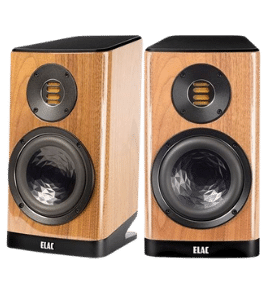LP Review, they don’t make music like that anymore (or album cover mistakes…), with Oscar Pettiford, Oscar Pettiford Orchestra in Hi-Fi, 1957 (Vol. 2)
NIPPON COLOMBIA, 1978 JAPAN RE-ISSUE OF ABC RECORDS YW-8555-AB (IN MONO)
Artist
Oscar Pettiford was (together with Charles Mingus) the top bassist of the 1945-1960 period. Furthermore, he was the first major jazz soloist on the cello. He can truly be considered one of the giants of the double bass.
He was born in 1922 on an Indian reservation in Okmulgee, Oklahoma (USA). Like so many great artists, “OP” as he was called by friends, was extremely talented from an early age. By age 10 he sang in front of the family band and by 14 he was playing the bass with obvious skill. Soon he would change the way the bass was played and experienced altogether.
OP became a regular performer in New York City’s jazz clubs, jamming with bebop pioneers. He had gigs with the best, Thelonious Monk, Coleman Hawkins, Roy Eldridge, Erroll Garner, and Max Roach. Creed Taylor, a famous record producer, commented that “OP had the strength and the rhythmic capacity to do things that were on the same level as Dizzy Gillespie and Charlie Parker”.
In 1945, OP joined Duke Ellington’s band, where he stayed for three years. When he played in Woody Herman’s band, he often played the cello. He was one of the first to incorporate that instrument into jazz performances.
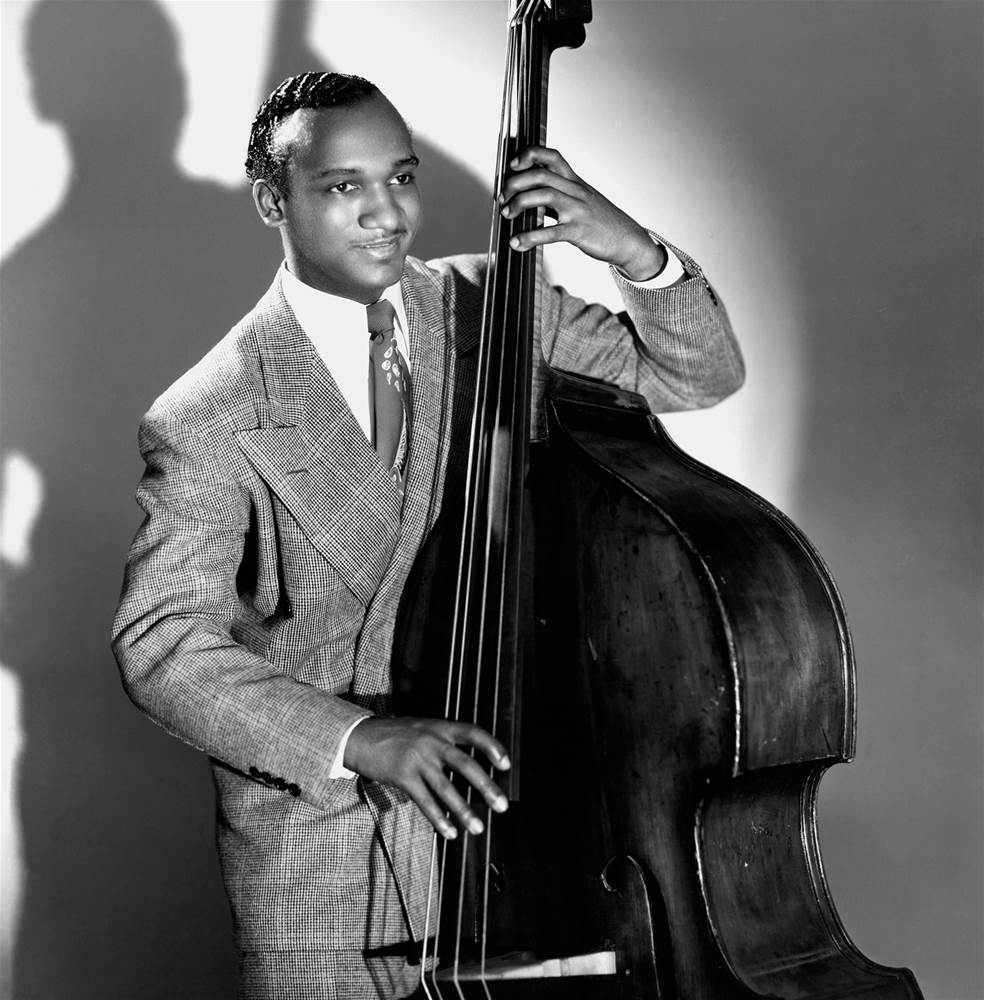
Label + Cover Art Snafu
Below you can see the famous and beautiful ABC Records rainbow label on the LP. Here is a link to the label variations ABC Records used. But before we proceed…
Not sure if he/she is still around 🙂 but I have a bone to pick with the person responsible for the marketing for this album at the time! Look at the cover. Do you see it? From the left, between ‘Jazz Men’ number 2 and 3. You can see what are clearly a woman’s legs, shoes, and skirt, the rest of her body is hidden, pushed to the back. This is weird. She obviously got an invite for the cover shoot :-). I can only imagine her surprise at the result!

Who was this lady? Most probably Betty Glamann who plays Harp on this album and who gets a shout-out on the back cover as “one of the greatest harpists in the swing idiom”. However, it could also be Janet Putnam, because that is who is listed as personnel on the record’s insert. So, who plays harp on this album then? Probably both, on different tracks spread across Vol. 1 and 2.
Regardless, it seems to me somewhat demeaning towards women. To add insult to injury, look at the top left cover – it says “O.P.’s jazz men’. Only men?? When they have two women in the band?? They invited one of the ladies to the cover shoot, put the album cover together and no one noticed that either Janet or Betty was left off :-)? Record company DUDES, there is no excuse, I know y’all lived in the 50s, but this was just rude.
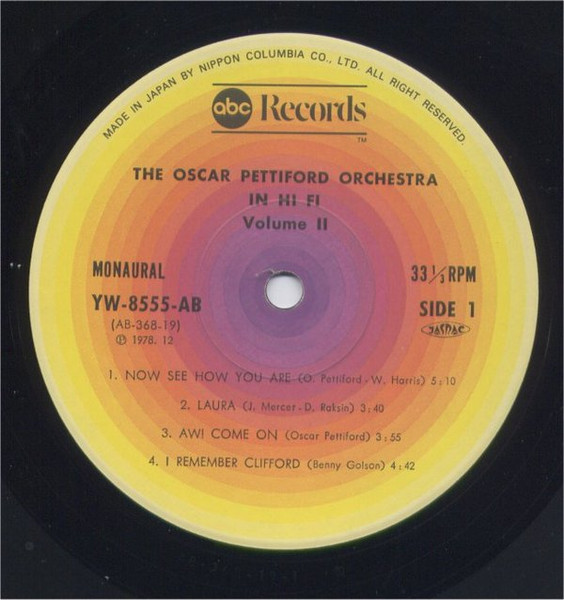
Music
This is a fantastic record. It’s unusual to have a harpist in jazz and it’s amazing to hear how the instrument blends in with the melodies. It was recorded in Mono and this is a good pressing so you get this great old sound, taking you back to the pre-stereo listening days.
The quality of the big band is outstanding and the soloists are amazing, what with Art Farmer, Bennie Golson, and Giggi Gryce. These artists embarked on very successful solo careers and it’s worth seeking out their records.
This is big band jazz at its best. It swings. It has interesting solo parts and it takes you back to the fifties when people still booked 15-20 piece orchestras. You can imagine the logistics and costs involved. Let’s be glad they did it so we can listen to it now. There are not a lot of photos online from OP’s orchestra but I found a nice one on a Japanese website. It gives you a good visual clue of how they looked and sounded at the time.
You can listen to this album on youtube. It’s the real deal in the big band sound.
RAW Store
The record is available online and in the store. If you are into big band music, I would get this if I were you, and it’s only 70 AED. The record looks unplayed to me.
Recording & Mastering Notes

A quick step back in LP history. Recorded in Mono, in New York City, on August 23, 1957, the original LP was issued in the US on ABC-Paramount and in the UK on His Master’s Voice, with what is arguably the most iconic label image ever produced. Nipper, the dog.
This image originated with His Master’s Voice, a British record label created in 1901 by The Gramophone Company. The image was taken from an 1890s painting by English artist Francis Barraud, which depicted a Jack Russell Terrier named Nipper listening to a wind-up disc gramophone. Later on, the Victor Talking Machine Company renamed RCA Victor and used it as its logo and trademark.
Back to our 1978 album which in itself has some nice graphical design touches. On the back cover, we find a wonderful note about optimal playback settings. Many of the records from the fifties had these references, It’s an interesting historical reminder of how people listened to ‘their stereo’.

You may have noticed Creed Taylor’s signature as the producer. Creed Taylor was later involved with the famous label CTI Records which he founded in 1967. That’s a whole new story – dig into it on Wikipedia if you like.
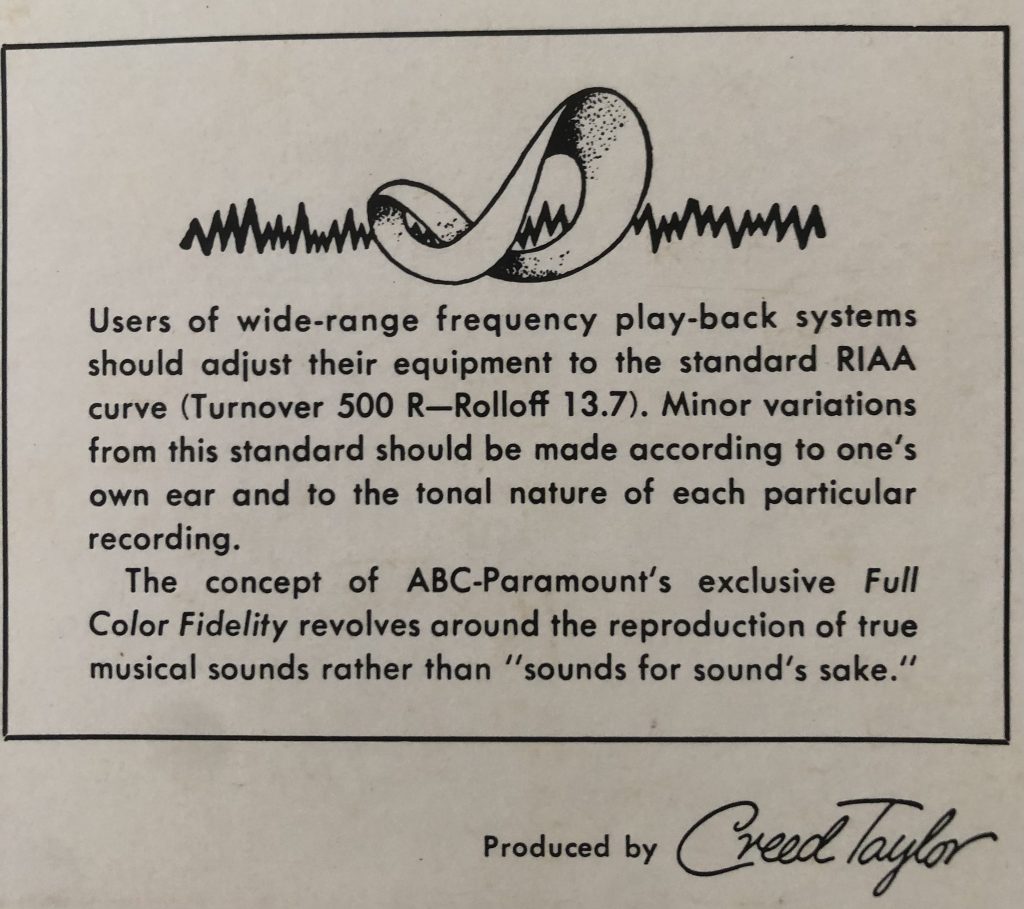
Tracks
Normally I list the tracks but this album sleeve has this wonderfully old-fashioned way of displaying them, so here’s a picture.

Personnel
Initially. I could not find who played in OP’s orchestra. The cover does not list them. Then I discovered that the Japanese language insert had a list of personnel. I am not 100% sure they listed all of them. The liner notes on the sleeve speak of a 17-piece band and here we only have 14. We seem to be 3 missing ‘men’…
- Ray Copeland (tp)
- Art Farmer (tp)
- Al grey (tb)
- Julius Watkins (frh)
- Dave Amran (frh)
- Gigi Gryce (as)
- Benny Golson (ts)
- Jerome Richardson (ts, fl)
- Sahib Shihab (bars)
- Dick Katz (p)
- Oscar Pettiford (b, cello)
- White Mitchell (b)
- Gus Johnson (dr)
- Janet Putnam (harp) – as listed on the insert, OR Betty Glamann – as per the liner notes on the back album cover.
Note: On the tunes, Seabreeze and Little Niles Kenny Dorham (tp) replaces either Copeland or Farmer
There is some confusion as to who played when in OP’s Orchestra. Apart from who played Harp on this issue and who is (partially) photographed on the front cover 😉
There was a compilation, released on CD in 2005, called Complete Big Band Studio Recordings – it sports the same cover photo as our review album – and `I think it combines Volumes 1 and 2 on one CD. From that release we gain some more information about the composition of the band during those recording sessions in New York City between 1956 and 1957:
- Alto Saxophone – Gigi Gryce
- Baritone Saxophone – Danny Bank , Dave Kurtzer, Sahib Shihab
- Bass – Oscar Pettiford, Whitey Mitchell
- Cello – Oscar Pettiford
- Drums – Gus Johnson, Osie Johnson
- French Horn – David Amram, Julius Watkins
- Harp – Betty Glamann, Janet Putnam
- Piano – Dick Katz, Tommy Flanagan
- Tenor Saxophone – Benny Golson, Lucky Thompson
- Tenor Saxophone, Flute – Jerome Richardson
- Trombone – Al Grey, Jimmy Cleveland
- Trumpet – Art Farmer, Ernie Royal, Kenny Dorham (tracks: 16,17), Ray Copeland
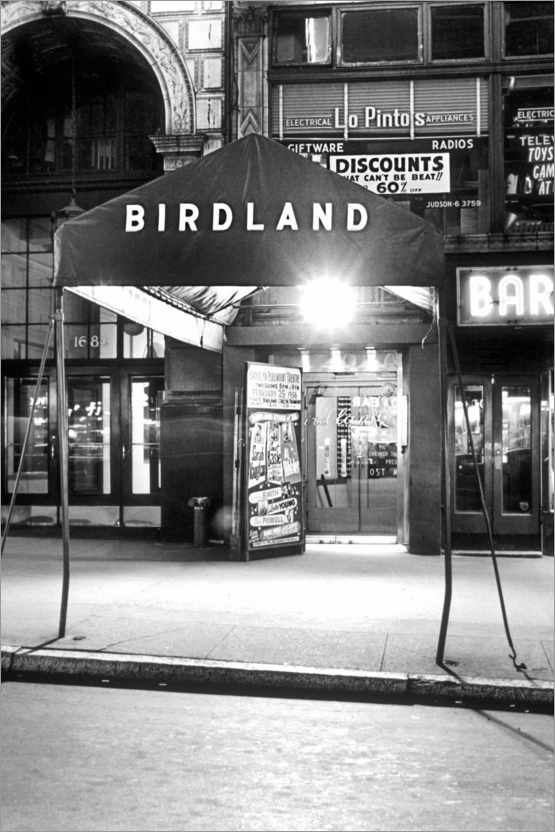
He also recorded in the famous jazz club ‘Birdland’ in the autumn of 1957 with the following band:
Art Farmer, possibly Ray Copeland or Kenny Dorham (tp), probably Al Grey (tb), probably Ed London, Dave Amram (frh), Gene Quill (as), Jerome Richardson (ts, fl), probably Benny Golson (ts), probably Sahib Shihab (brs), Dick Katz (p), Betty Glamann (harp), Oscar Pettiford (b, cello), Gus Johnson or Shadow Wilson (d)


